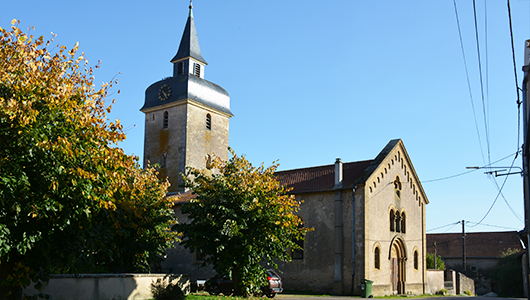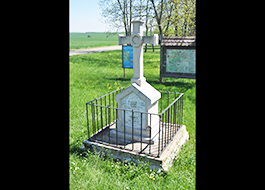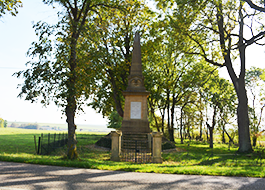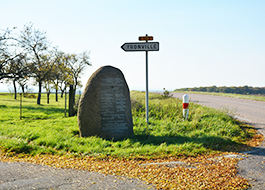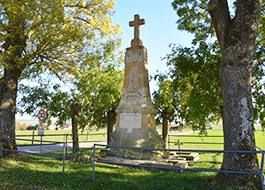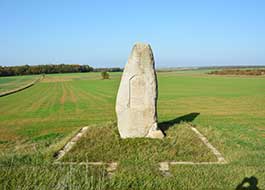Vionville
Durée visite : 50 minutes
Moyen : Pédestre
Le village dépendait de l’ancienne Terre de Gorze. Celle-ci était constituée d’une vingtaine de villages. Elle formait le domaine de l’abbaye bénédictine Saint-Gorgon de Gorze. Les seigneurs étaient les comtes de Bar. La Terre de Gorze est prise d’assaut par les troupes de Claude de Lorraine, duc de Guise. En 1661, par le traité de Vincennes, elle est cédée à la France. En 1870, Vionville fut le théâtre de durs combats au cours de la guerre franco-prussienne. En septembre 1944, la commune fut durement éprouvée au cours de la bataille de Metz.
The village depended on the former Terre de Gorze. This was made up of about twenty villages. It formed the domain of the Benedictine Abbey of Saint-Gorgon de Gorze. The lords were the counts of Bar. The Terre de Gorze is stormed by the troops of Claude de Lorraine, Duke of Guise. In 1661, by the Treaty of Vincennes, it was ceded to France. In 1870, Vionville was the scene of heavy fighting during the Franco-Prussian war. In September 1944, the town was severely tested during the Battle of Metz.
Das Dorf war abhängig von den ehemaligen Terre de Gorze. Diese bestand aus ungefähr zwanzig Dörfern. Es bildete die Domäne der Benediktinerabtei von Saint-Gorgon de Gorze. Die Herren waren die Grafen von Bar. Die Terre de Gorze wird von den Truppen von Claude de Lorraine, Herzog von Guise, gestürmt. 1661 wurde es durch den Vertrag von Vincennes an Frankreich abgetreten. 1870 war Vionville Schauplatz heftiger Kämpfe während des Deutsch-Französischen Krieges. Im September 1944 wurde die Stadt während der Schlacht von Metz streng getestet.

D’azur au Saint-Gorgon à cheval armé de pied en cap, accompagné de trois molettes d’éperon, le tout d’or.
Aux armes de la terre de Gorze (Saint Gorgon) on a ajouté des molettes pour évoquer la bataille du 16 août 1870.
Azure in Saint-Gorgon on horseback armed from head to toe, accompanied by three spur knurls, all gold.
To the arms of the land of Gorze (Saint Gorgon) we added knurls to evoke the battle of August 16, 1870.
Azure in Saint-Gorgon zu Pferd, von Kopf bis Fuß bewaffnet, begleitet von drei Spornrändeln, alle aus Gold.
Zu den Armen des Landes Gorze (Saint Gorgon) fügten wir Rändelungen hinzu, um die Schlacht vom 16. August 1870 hervorzurufen.

Lés pètes de jau = les pattes de coq.
Les habitants de plusieurs villages autour des anciennes léproseries du Longeau, de Malmaison et autres sont affligés de vilains surnoms très variés qui tous rappellent la lèpre qui a régné autrefois chez eux, comme Châtel – St.-Germain, Vernéville, Rezonville, Vionville et plus loin Semécourt et Pierrevillers.
En ce qui concerne Vionville, il y a lieu de donner le, précisions sur le symptôme suivant :
Il consiste dans la rétraction des muscles fléchisseurs des doigts de la main, de sorte que les doigts ne peuvent plus se désarticuler; les ongles se recourbent, s’aplatissent et s’appointissent en griffes, ressemblant à celles d’un oiseau de proie ou aux pattes de gallinacés. On peut supposer que beaucoup de ces villageois ont été éprouvés par ces lésions, car l’appellatif populaire se plaît à rappeler cette condition sociale de jadis.
Réf. de Westphalen, Petit Dictionnaire, p. 680
Lés pètes de jau = rooster’s feet.
The inhabitants of several villages around the old leper colonies of Longeau, Malmaison and others are afflicted with a wide variety of nasty nicknames which all recall the leprosy that once reigned in them, such as Châtel – St.-Germain, Vernéville, Rezonville, Vionville and more far Semécourt and Pierrevillers.
With regard to Vionville, it is necessary to give the details of the following symptom:
It consists in the retraction of the flexor muscles of the fingers of the hand, so that the fingers can no longer disarticulate; the fingernails curl, flatten and tap into claws, resembling those of a bird of prey or the paws of gallinaceous animals. One can suppose that many of these villagers were tested by these lesions, because the popular name likes to recall this social condition of old.
Ref. de Westphalen, Small Dictionary, p. 680
Lés pètes de jau = Hahnfüße.
Die Bewohner mehrerer Dörfer rund um die alten Leprakolonien Longeau, Malmaison und andere leiden unter einer Vielzahl böser Spitznamen, die alle an die einst in ihnen herrschende Lepra erinnern, wie Châtel – St. Germain, Vernéville, Rezonville, Vionville und andere weit Semécourt und Pierrevillers.
In Bezug auf Vionville ist es notwendig, die Details des folgenden Symptoms anzugeben:
Es besteht im Zurückziehen der Beugemuskeln der Finger der Hand, so dass die Finger nicht mehr disartikulieren können; Die Fingernägel kräuseln sich, drücken sich flach und klopfen in Krallen, die denen eines Greifvogels oder den Pfoten gallinaceöser Tiere ähneln. Man kann annehmen, dass viele dieser Dorfbewohner durch diese Läsionen getestet wurden, weil der populäre Name gerne an diesen alten sozialen Zustand erinnert.
Ref. de Westphalen, Kleines Wörterbuch, p. 680

Les habitants et les habitantes de Vionville s’appellent les Vionvillois et les Vionvilloises.
The inhabitants of Vionville are called Vionvillois and Vionvilloises.
Die Einwohner von Vionville heißen Vionvillois und Vionvilloises.
Les points de visites
.
Le monument est dû sculpteur Jacquemin de Metz. Il s’agit d’une stèle façonnée dans un bloc de calcaire blanc. Il présente une croix ouvragée en marbre blanc. La croix actuelle remplace la croix d’origine, disparue. La première dédicace disait : À la mémoire de M. le Comte Antoine de Levezou de Vesins, lieutenant au 93 de ligne, blessé mortellement le 16 août 1870 à Gravelotte, sur le champ de bataille le 17 août, décédé le même jour à l’ambulance de Vionville l’âge de 25 ans. Priez pour lui ! Dites à ma mère que je meurs en chrétien et en soldat marchez en avant! Le comte Antoine de Levezou de Vezins Vesins était le petit-fils du maréchal Oudinot. Lieutenant au 93e de ligne, il est blessé le 16 août. Resté la nuit sur le champ de bataille et emmené seulement le lendemain dans une ambulance allemande à Vionville. il y décède le même jour, et est enterré sur place. après la guerre. Son père. venu spécialement à Metz. cherche son corps en vain. Deux soldats lui apprennent qu’ils ont procédé à l’inhumation du lieutenant. Le corps est exhumé et emmené au château de Caylus, près de Montauban, où il est inhumé. Le monument, dégradé, est restauré par le Souvenir français. La croix et la plaque qui avaient disparu sont remplacées.
The monument is due to sculptor Jacquemin de Metz. It is a stele fashioned from a block of white limestone. It presents an ornate cross in white marble. The current cross replaces the original cross, which has disappeared. The first dedication read: In memory of M. le Comte Antoine de Levezou de Vesins, lieutenant in the 93 line, fatally wounded on August 16, 1870 at Gravelotte, on the battlefield on August 17, died the same day in the Vionville ambulance age 25. Pray for him! Tell my mother that I die as a Christian and as a soldier march forward! Count Antoine de Levezou de Vezins Vesins was the grandson of Marshal Oudinot. Lieutenant in the 93rd of the line, he was wounded on August 16. Stayed overnight on the battlefield and only taken the next day in a German ambulance to Vionville. he died there the same day, and was buried there. after the war. His father. came especially to Metz. searches for his body in vain. Two soldiers tell him that they have buried the lieutenant. The body is exhumed and taken to the castle of Caylus, near Montauban, where it is buried. The monument, degraded, is restored by the French Souvenir. The cross and the plaque which had disappeared are replaced.
Das Denkmal stammt von der Bildhauerin Jacquemin de Metz. Es ist eine Stele aus einem weißen Kalksteinblock. Es zeigt ein reich verziertes Kreuz aus weißem Marmor. Das aktuelle Kreuz ersetzt das ursprüngliche Kreuz, das verschwunden ist. Die erste Widmung lautete: In Erinnerung an M. le Comte Antoine de Levezou de Vesins starb der Leutnant der Linie 93, der am 16. August 1870 in Gravelotte auf dem Schlachtfeld am 17. August tödlich verwundet worden war, am selben Tag im Vionville Krankenwagen Alter 25. Bete für ihn! Sagen Sie meiner Mutter, dass ich als Christin und als Soldat vorwärts marschiere! Graf Antoine de Levezou de Vezins Vesins war der Enkel von Marschall Oudinot. Leutnant im 93. der Linie, wurde er am 16. August verwundet. Ich blieb über Nacht auf dem Schlachtfeld und fuhr erst am nächsten Tag mit einem deutschen Krankenwagen nach Vionville. Er starb dort am selben Tag und wurde dort begraben. nach dem Krieg. Sein Vater. kam vor allem nach Metz. sucht vergebens nach seinem Körper. Zwei Soldaten sagen ihm, dass sie den Leutnant begraben haben. Die Leiche wird exhumiert und zur Burg von Caylus in der Nähe von Montauban gebracht, wo sie begraben liegt. Das degradierte Denkmal wird vom französischen Souvenir restauriert. Das Kreuz und die verschwundene Plakette werden ersetzt.
.
.
Un soubassement octogonal en pierre de taille s’élève sur deux gradins. Ce soubassement porte une colonne tronconique terminée par un dôme. Elle est surmontée d’une Croix de fer en pierre. Sous la coupole. une frise sculptée présente des tètes de lions en médaillon, symbole de la bravoure. Les guirlandes de feuilles de chêne enrubannées représentent l’opiniâtreté. Trois bandeaux en marbre noir ceinturent le fût de la colonne. On peut y lire, gravés, les noms des tués. Entre les deux bandeaux inférieurs, on trouve l’inscription: Dédié par le 3e régiment d’infanterie brandebourgeois n° 20, à ses camarades tombés le 16 août 1870, dans la bataille de Vionville. Le monument est haut de sept mètres. Il est l’œuvre du sculpteur messin H. Heister. Le 20e régiment d’infanterie participe à la prise de Vionville puis de Flavigny. Une partie de l’IR 20 tente en vain prendre le bois de Tronville. Le régiment a ensuite beaucoup de peine à endiguer l’attaque française, lancée depuis Rezonville. Les pertes sont de 8 officiers et 154 hommes tués, ainsi que 34 officiers et 533 hommes blessés. Inauguré en février 1873, le monument est en pierre de Jaumont. Il est élevé à l’emplacement d’une batterie française prise par l’IR 20.
An octagonal cut stone base rises on two steps. This base has a tapered column ending in a dome. It is surmounted by an iron cross in stone. Under the dome. a sculpted frieze presents the heads of lions in a medallion, a symbol of bravery. The wreaths of wrapped oak leaves represent stubbornness. Three black marble bands surround the shaft of the column. The names of those killed can be read there. Between the two lower bands, we find the inscription: Dedicated by the 3rd Brandenburg Infantry Regiment n ° 20, to his comrades who fell on August 16, 1870, in the battle of Vionville. The monument is seven meters high. It is the work of the sculptor Messin H. Heister. The 20th infantry regiment took part in the capture of Vionville and then of Flavigny. Part of the IR 20 tries in vain to take the wood of Tronville. The regiment then had great difficulty in stemming the French attack, launched from Rezonville. The losses are 8 officers and 154 men killed, as well as 34 officers and 533 men wounded. Inaugurated in February 1873, the monument is made of Jaumont stone. It was built on the site of a French battery taken by the IR 20.
Eine achteckig geschnittene Steinbasis erhebt sich auf zwei Stufen. Diese Basis hat eine sich verjüngende Säule, die in einer Kuppel endet. Es wird von einem eisernen Kreuz in Stein überragt. Unter der Kuppel. Ein geformter Fries zeigt die Löwenköpfe in einem Medaillon, einem Symbol der Tapferkeit. Die Kränze aus eingewickelten Eichenblättern stehen für Sturheit. Drei schwarze Marmorbänder umgeben den Schaft der Säule. Dort können die Namen der Getöteten nachgelesen werden. Zwischen den beiden unteren Bändern befindet sich die Inschrift: Vom 3. brandenburgischen Infanterieregiment Nr. 20 seinen Kameraden gewidmet, die am 16. August 1870 in der Schlacht von Vionville gefallen sind. Das Denkmal ist sieben Meter hoch. Es ist das Werk des Bildhauers Messin H. Heister. Das 20. Infanterieregiment nahm an der Eroberung von Vionville und dann von Flavigny teil. Ein Teil der IR 20 versucht vergeblich, das Holz von Tronville einzunehmen. Das Regiment hatte dann große Schwierigkeiten, den von Rezonville aus gestarteten französischen Angriff einzudämmen. Die Verluste betragen 8 Offiziere und 154 getötete Männer sowie 34 Offiziere und 533 verwundete Männer. Das im Februar 1873 eingeweihte Denkmal besteht aus Jaumont-Stein. Es wurde an der Stelle einer französischen Batterie gebaut, die vom IR 20 übernommen wurde.
.
Haut de 11 mètres, le monument est constitué d’un soubassement octogonal. Il supporte un socle massif auquel on accède par un escalier de sept marches. Ce socle est surmonté d’un obélisque. L’ensemble est en pierre de Jaumont. La base de l’obélisque est ornée, sur sa face avant, d’un aigle perché sur un boulet, ce dernier en partie recouvert d’une banderole où on peut lire: Vionville — le 16 août 1870. Les autres faces de la base de l’obélisque portent des plaques de marbre blanc décorées de deux rameaux de chêne gravés. Y sont inscrites les batailles auxquelles ont pris part les bataillons du régiment. Le socle porte aussi des plaques de marbre. Celle de la face avant, la seule à avoir été détruite, comportait une grande Croix de fer, ainsi que la dédicace: Le régiment de fusiliers brandebourgeois n° 35 aux camarades tombés. Une plaque moderne la remplace. Les plaques apposées sur les autres faces présentent les tués, selon un classement par bataillon et compagnie. Le monument est l’œuvre du marbrier L. André de Metz. Il est inauguré en 1873.
Le Brandenburgisches Füsilier-Regiment Nr. 35 est engagé dans le même secteur que l’IR 20. Avec ce dernier et l’IR 64, il enveloppe sur trois côtés Vionville, qui est pris en fin de matinée. Lancé ensuite contre Flavigny, il enregistre de lourdes pertes. Grâce à l’artillerie du III. Korps, le régiment peut, au cours d’une seconde offensive, prendre d’assaut le village. Les pertes sont élevées : sept officiers et 250 hommes tués, 18 officiers et 584 hommes blessés. Lors de l’inauguration, le général von Rothmaler, commandant la brigade au cours de la bataille, fait le déplacement. Le comte von Haeseler, ancien chef d’état-major de la 2e Armée se déplace pour assister à la cérémonie.
11 meters high, the monument consists of an octagonal base. It supports a massive plinth which is accessed by a staircase of seven steps. This plinth is surmounted by an obelisk. The set is in Jaumont stone. The base of the obelisk is adorned, on its front face, with an eagle perched on a ball, the latter partly covered with a banner which reads: Vionville – August 16, 1870. The other faces of the base of the obelisk bear white marble plaques decorated with two engraved oak branches. It lists the battles in which the battalions of the regiment took part. The plinth also carries marble slabs. The one on the front, the only one to have been destroyed, included a large Iron Cross, as well as the dedication: The Brandenburg Rifle Regiment No. 35 to the Fallen Comrades. A modern plate replaces it. The plaques affixed to the other faces present the killed, according to a classification by battalion and company. The monument is the work of marble artist L. André de Metz. It was inaugurated in 1873.
The Brandenburgisches Füsilier-Regiment Nr. 35 is engaged in the same sector than IR 20. With the latter and IR 64, it wraps around Vionville on three sides, which is caught in the late morning. Then launched against Flavigny, it recorded heavy losses. Thanks to the artillery of III. Korps, the regiment can, during a second offensive, storm the village. The losses are high: seven officers and 250 men killed, 18 officers and 584 men wounded. During the inauguration, General von Rothmaler, commander of the brigade during the battle, made the trip. Count von Haeseler, former Chief of Staff of the 2nd Army comes to attend the ceremony.
Das 11 Meter hohe Denkmal besteht aus einem achteckigen Sockel. Es trägt eine massive Basis, die über eine Treppe mit sieben Stufen zugänglich ist. Dieser Sockel wird von einem Obelisken überragt. Das Set ist aus Jaumont Stein. Die Basis des Obelisken ist auf seiner Vorderseite mit einem Adler geschmückt, der auf einer Kugel thront. Letztere ist teilweise mit einem Banner bedeckt, auf dem steht: Vionville – 16. August 1870. Die anderen Seiten der Basis der Obelisken tragen weiße Marmortafeln, die mit zwei gravierten Eichenzweigen verziert sind. Es listet die Schlachten auf, an denen die Bataillone des Regiments teilgenommen haben. Der Sockel trägt auch Marmorplatten. Die einzige auf der Vorderseite, die als einzige zerstört wurde, enthielt ein großes Eisernes Kreuz sowie die Widmung: Das brandenburgische Gewehrregiment Nr. 35 an die gefallenen Genossen. Eine moderne Platte ersetzt es. Die an den anderen Gesichtern angebrachten Plaketten stellen die Toten nach einer Klassifizierung nach Bataillon und Kompanie dar. Das Denkmal ist das Werk des Marmorkünstlers L. André de Metz. Es wurde 1873 eingeweiht.
Das Brandenburgische Füsilier-Regiment Nr. 35 ist im gleichen Sektor tätig als IR 20. Mit letzterem und IR 64 wickelt es sich auf drei Seiten um Vionville, das am späten Morgen gefangen wird. Dann gegen Flavigny gestartet, verzeichnete es schwere Verluste. Dank der Artillerie von III. Korps, das Regiment kann während einer zweiten Offensive das Dorf stürmen. Die Verluste sind hoch: sieben Offiziere und 250 Männer getötet, 18 Offiziere und 584 Männer verwundet. Während der Einweihung machte General von Rothmaler, Kommandeur der Brigade während der Schlacht, die Reise. Graf von Haeseler, ehemaliger Stabschef der 2. Armee, kommt zur Zeremonie.
.
Un poids public, ou bascule publique, est un ouvrage architectural. Il est situé généralement au centre d’une commune, à proximité d’une gare, d’un bureau de poste ou d’un lieu de marché. Il permet de déterminer le poids de tout véhicule routier ou d’animaux tels que des porcs ou vaches, pour ensuite les vendre à un prix en fonction de leur masse. Tout au long du XIXe siècle, le domaine des poids et mesures est dominé par la mise en place du Système métrique décimal. C’est une véritable épopée métrologique. Elle représente par son ampleur et son impact une entreprise inédite dans l’histoire de l’humanité. Mais, bien que le Système métrique soit né à la fin du XVIIIe siècle, il aura fallu attendre le 1er janvier 1840, pour qu’il soit définitivement établi en France, dans les formes originelles adoptées le 7 avril 1795.
A public weight, or public rocker, is an architectural work. It is generally located in the center of a town, near a train station, a post office or a market place. It makes it possible to determine the weight of any road vehicle or of animals such as pigs or cows, to then sell them at a price according to their mass. Throughout the 19th century, the field of weights and measures was dominated by the establishment of the Decimal Metric System. It is a real metrological epic. By virtue of its scale and its impact, it represents an unprecedented undertaking in the history of humanity. But, although the Metric System was born at the end of the 18th century, it was not until January 1, 1840, for it to be definitively established in France, in the original forms adopted on April 7, 1795.
Ein öffentliches Gewicht oder ein öffentlicher Rocker ist ein architektonisches Werk. Es befindet sich in der Regel im Zentrum einer Stadt, in der Nähe eines Bahnhofs, einer Post oder eines Marktplatzes. Es ermöglicht, das Gewicht eines Straßenfahrzeugs oder von Tieren wie Schweinen oder Kühen zu bestimmen und diese dann zu einem Preis zu verkaufen, der ihrer Masse entspricht. Während des gesamten 19. Jahrhunderts wurde das Feld der Gewichte und Maße durch die Einrichtung des Dezimalmetriksystems dominiert. Es ist ein echtes messtechnisches Epos. Aufgrund seines Ausmaßes und seiner Wirkung ist es ein beispielloses Unterfangen in der Geschichte der Menschheit. Obwohl das metrische System Ende des 18. Jahrhunderts geboren wurde, wurde es erst am 1. Januar 1840 in Frankreich in den ursprünglichen Formen, die am 7. April 1795 angenommen wurden, endgültig etabliert.
.
C’est un monument en granit brut. On peut y lire :
Fidèles jusqu’à la mort, à leur roi et à la patrie, reposent sur le champ de bataille de Vionville — Mars-la-Tour – 16 août 1870 – les valeureux guerriers suivants du 10e régiment d’artillerie de campagne hanovrien.
Suit la liste des pertes. Puis, en dessous :
Érigé, le 16 août 1911, en l’honneur des braves qui sont tombés, par le corps des officiers de réserve et des officiers de santé, d’aujourd’hui et d’autrefois, du 10e régiment d’artillerie de campagne von Scharnhorst, et du 74e régiment d’artillerie de campagne de Torgau — Nos biens et notre sang sont à l’empereur et à l’Empire.
Le 16 août, l’artillerie du Xe Korps arrive sur le champ de bataille. Il renforce les pièces du IIIe Korps. Le régiment perd deux officiers et 68 hommes, et dénombre 16 officiers et 204 hommes blessés. Le monument est inauguré le 16 août 1911, en présence du général d’artillerie von Körber, qui commandait l’artillerie montée du Régiment Nr. 10 en 1870. Le monument est endommagé après 1918.
It is a monument in raw granite. We can read there:
Faithful to death, to their king and to their homeland, rest on the battlefield of Vionville – Mars-la-Tour – August 16, 1870 – the following valiant warriors of the 10th Hanoverian Field Artillery Regiment.
The list of losses follows. Then, below :
Erected on August 16, 1911, in honor of the braves who have fallen, by the corps of reserve and health officers, today and in the past, of the 10th Field Artillery Regiment von Scharnhorst , and the 74th Field Artillery Regiment of Torgau – Our property and our blood belong to the Emperor and the Empire.
On August 16, the artillery of the Xth Korps arrived on the battlefield. It reinforces the pieces of the 3rd Korps. The regiment lost two officers and 68 men, and counted 16 officers and 204 wounded men. The monument was inaugurated on August 16, 1911, in the presence of Artillery General von Körber, who commanded the mounted artillery of Regiment No. 10 in 1870. The monument was damaged after 1918.
Es ist ein Denkmal aus rohem Granit. Wir können dort lesen:
Bis zum Tod treu, ihrem König und ihrer Heimat, ruhen auf dem Schlachtfeld von Vionville – Mars-la-Tour – 16. August 1870 – die folgenden tapferen Krieger des 10. hannoverschen Feldartillerie-Regiments.
Die Liste der Verluste folgt. Dann unten:
Errichtet am 16. August 1911 zu Ehren der Mutigen, die heute und in der Vergangenheit vom Korps der Reserve- und Gesundheitsbeamten des 10. Feldartillerie-Regiments von Scharnhorst gefallen sind und des 74. Feldartillerie-Regiments von Torgau – Unsere Güter und unser Blut gehören dem Kaiser und dem Imperium.
Am 16. August traf die Artillerie des X. Korps auf dem Schlachtfeld ein. Es verstärkt die Teile des 3. Korps. Das Regiment verlor zwei Offiziere und 68 Männer und zählte 16 Offiziere und 204 Verwundete. Das Denkmal wurde am 16. August 1911 in Anwesenheit von Artillerie-General von Körber eingeweiht, der 1870 die berittene Artillerie des Regiments Nr. 10 befehligte. Das Denkmal wurde nach 1918 beschädigt.
.
Le soubassement est en grès, en forme de rocher. Il repose sur une plate-forme en pierre et porte une grande stèle en pierre de Jaumont. Cette dernière comporte des parties en grès sculptées : une frise formée de rameaux et de rubans à mi-hauteur, une palme avec une banderole marquée « pro patria » et, en haut, une couronne mortuaire entourant 16 août 1870. Une croix, qui provient d’une ancienne tombe allemande, surmonte l’ensemble. Une ancienne plaque de dédicace allemande a été utilisée pour y graver ce texte:
Aux officiers et soldats français tombés sur le champ de bataille — Vionville le 16 août 1870 la commune de Vionville.
Derrière, deux croix en béton portant l’inscription « 1870-71 » matérialisent un ossuaire. Cet édifice est le reliquat d’un premier monument, celui de l’IR 57. Il fut inauguré en 1897. Sur ce soubassement s’élevait un lion sculpté. Il fut détruit par des soldats américains ivres, en 1919. Le 8e Westfälisches Infanterie-Regiment Nr 57 forme avec l’IR 16 la 38e Infanterie-Brigade Wedell du Xe Korps. La brigade part le matin du 16 août de Thiaucourt. Des troupes françaises ont pris position de l’autre côté du ravin du Fond de la Cuve, autour de la ferme de Grizières. Vers 17 heures, la brigade Wedell est alors engagée avec, comme objectif, de prendre cette ferme. Soumis à des tirs meurtriers à l’approche du ravin, les deux régiments sont décimés. Seule, l’intervention du Garde-Dragoner Regiment nr 1 permet d’éviter un désastre complet, en empêchant les troupes françaises de continuer la poursuite. Les survivants des IR 16 et 57 peuvent battre en retraite. L’Ir 57 a perdu, à l’issue de l’attaque,16 officiers et 366 hommes, alors que 17 autres officiers et 422 hommes sont bléssés. Les restes de 12 officiers et 390 soldats français sont regroupés en 1924. La commune de Vionville réutilise le socle du monument allemand. Le 22 mars 1925, lors de l’inauguration, Jean-Pierre Jean, président du Souvenir français, justifie l’opération en ces termes :
Que ceux qui. peut-être, oseraient prétendre ici au droit de propriété d’un régiment prussien, s’adressent à vous, gens de Vionville. Vous leur direz que le terrain choisi a été largement payé par le sang de nos 15 952 braves défenseurs du 16 août 1870, et par celui des 1,5 million de libérateurs de 1914 1918.
The base is made of sandstone, in the shape of a rock. It rests on a stone platform and carries a large stele in Jaumont stone. The latter has carved sandstone parts: a frieze formed of twigs and ribbons at mid-height, a palm with a banner marked « pro patria » and, at the top, a funeral wreath surrounding August 16, 1870. A cross, which comes from of an old German tomb, surmounts the whole. An old German dedication plaque was used to engrave this text:
To the French officers and soldiers fallen on the battlefield – Vionville on August 16, 1870 the commune of Vionville.
Behind, two concrete crosses bearing the inscription “1870-71” materialize an ossuary. This building is the remainder of a first monument, that of IR 57. It was inaugurated in 1897. On this base rose a sculpted lion. It was destroyed by drunk American soldiers in 1919. The 8th Westfälisches Infanterie-Regiment Nr 57 forms with the IR 16 the 38th Wedell Infantry-Brigade of the Xth Korps. The brigade left on the morning of August 16 from Thiaucourt. French troops took up positions on the other side of the Fond de la Cuve ravine, around the Grizières farm. Around 5 p.m., the Wedell brigade was then engaged with the objective of taking this farm. Subjected to deadly gunfire as the ravine approached, the two regiments were decimated. Only the intervention of Garde-Dragoner Regiment nr 1 made it possible to avoid a complete disaster, by preventing the French troops from continuing the pursuit. Survivors of IR 16 and 57 may retreat. The Ir 57 lost, after the attack, 16 officers and 366 men, while 17 other officers and 422 men were wounded. The remains of 12 officers and 390 French soldiers were regrouped in 1924. The town of Vionville reuse the base of the German monument. On March 22, 1925, during the inauguration, Jean-Pierre Jean, president of the Souvenir français, justifies the operation in these terms:
Than those who. perhaps, would dare to claim here the right of ownership of a Prussian regiment, address themselves to you, people of Vionville. You will tell them that the chosen land was largely paid for by the blood of our 15,952 brave defenders of August 16, 1870, and that of the 1.5 million liberators of 1914 1918.
Die Basis besteht aus Sandstein in Form eines Felsens. Es ruht auf einer Steinplattform und trägt eine große Stele aus Jaumont-Stein. Letzterer hat Sandsteinteile geschnitzt: einen Fries aus Zweigen und Bändern in mittlerer Höhe, eine Palme mit einem Banner mit der Aufschrift « pro patria » und oben einen Trauerkranz um den 16. August 1870. Ein Kreuz, das von stammt eines alten deutschen Grabes überragt das Ganze. Für die Gravur dieses Textes wurde eine alte deutsche Widmungstafel verwendet:
An die französischen Offiziere und Soldaten, die am 16. August 1870 auf dem Schlachtfeld fielen – Vionville die Gemeinde Vionville.
Dahinter materialisieren zwei Betonkreuze mit der Aufschrift „1870-71“ ein Beinhaus. Dieses Gebäude ist der Rest eines ersten Denkmals, des IR 57. Es wurde 1897 eingeweiht. Auf dieser Basis stand ein skulptierter Löwe. Es wurde 1919 von betrunkenen amerikanischen Soldaten zerstört. Das 8. Westfälische Infanterie-Regiment Nr. 57 bildet mit der IR 16 die 38. Wedell-Infanterie-Brigade des X. Korps. Die Brigade verließ am Morgen des 16. August Thiaucourt. Französische Truppen haben auf der anderen Seite der Schlucht Fond de la Cuve rund um die Farm Grizières Stellung bezogen. Gegen 17 Uhr wurde die Wedell-Brigade mit dem Ziel beauftragt, diese Farm zu übernehmen. Die beiden Regimenter wurden bei ihrer Annäherung an die Schlucht tödlichen Schüssen ausgesetzt und dezimiert. Nur die Intervention des Garde-Dragoner-Regiments Nr. 1 ermöglichte es, eine vollständige Katastrophe zu vermeiden, indem die französischen Truppen daran gehindert wurden, die Verfolgung fortzusetzen. Überlebende von IR 16 und 57 können sich zurückziehen. Die Ir 57 verlor nach dem Angriff 16 Offiziere und 366 Männer, während 17 weitere Offiziere und 422 Männer verwundet wurden. Die Überreste von 12 Offizieren und 390 französischen Soldaten wurden 1924 zusammengefasst. Die Stadt Vionville verwendet die Basis des deutschen Denkmals wieder. Am 22. März 1925 begründet Jean-Pierre Jean, Präsident des Souvenir français, während der Amtseinführung die Operation folgendermaßen:
Als diejenigen, die. Vielleicht würde ich es wagen, hier das Eigentumsrecht eines preußischen Regiments zu beanspruchen und mich an Sie, Leute von Vionville, zu wenden. Sie werden ihnen sagen, dass das ausgewählte Land größtenteils durch das Blut unserer 15.952 tapferen Verteidiger vom 16. August 1870 und das der 1,5 Millionen Befreier von 1914 bis 1918 bezahlt wurde.
.
Le monument est en granit brut, haut de quatre mètres et d’un poids de 15 tonnes. Il provient des Brockengebirge dans le Harz. Du côté de la route, sont gravés les différents faits du régiment pendant la guerre. Autrefois se trouvait à la place une plaque en bronze avec cette dédicace:
« Le régiment d’infanterie nr 79 von Voigts-Rhetz (3e hanovrien), à la mémoire des camarades du régiment tombés lors de leur baptême du feu, sur ce champ de bataille et pendant la campagne 1870-71. Érigé le 16 août 1913 »
À l’arrière du monument. où étaient gravés originellement les faits d’armes, se trouve maintenant le texte de la dédicace originelle auquel on a ajouté: détruit en 1918 – redressé en 1942 . Le 3e Hannoversches Infanterie-Regiment Nr. 79 forme avec l’IR 56 la 39e Infanterie-Brigade appartenant au X Korps. Le 16 août 1870, il subit des pertes dans l’attaque du bois de Tronville: deux officiers et 65 hommes tués ainsi que 16 officiers et 233 hommes blessés. Le monument constitue un don jubilaire des vétérans pour le 75′ anniversaire du régiment. Inauguré en 1913, c’ est le dernier monument commémoratif de 1870 construit en Lorraine par les Allemands avant 1914. Le monument est particulièrement dégradé en 1918. Le bloc de granit est renversé. Durant la période nazie, le monolithe est redressé en 1942.
The monument is in raw granite, four meters high and weighing 15 tons. It comes from the Brockengebirge in the Harz. On the side of the road, are engraved the various facts of the regiment during the war. In the past there was a bronze plaque with this dedication instead:
«The infantry regiment nr 79 von Voigts-Rhetz (3rd Hanoverian), in memory of the comrades of the regiment who fell during their baptism of fire, on this battlefield and during the 1870-71 campaign. Erected August 16, 1913 »
At the back of the monument. where the feats of arms were originally engraved, is now the text of the original dedication to which has been added: destroyed in 1918 – rectified in 1942. The 3rd Hannoversches Infanterie-Regiment Nr. 79 forms with the IR 56 the 39th Infantry-Brigade belonging to the X Korps. On August 16, 1870, he suffered losses in the attack on the Bois de Tronville: two officers and 65 men killed as well as 16 officers and 233 men wounded. The monument is a jubilee gift from veterans for the regiment’s 75th anniversary. Inaugurated in 1913, it is the last commemorative monument of 1870 built in Lorraine by the Germans before 1914. The monument is particularly degraded in 1918. The block of granite is overturned. During the Nazi period, the monolith was straightened in 1942.
Das Denkmal ist aus rohem Granit, vier Meter hoch und 15 Tonnen schwer. Es kommt aus dem Brockengebirge im Harz. Am Straßenrand sind die verschiedenen Fakten des Regiments während des Krieges eingraviert. In der Vergangenheit gab es stattdessen eine Bronzetafel mit dieser Widmung:
«Das Infanterieregiment Nr. 79 von Voigts-Rhetz (3. Hannoveraner), in Erinnerung an die Genossen des Regiments, die während ihrer Feuertaufe auf diesem Schlachtfeld und während des Feldzugs 1870-71 gefallen sind. Errichtet am 16. August 1913 »
Auf der Rückseite des Denkmals. Wo ursprünglich die Waffenstücke eingraviert wurden, ist jetzt der Text der ursprünglichen Widmung, zu der wir hinzugefügt haben: 1918 zerstört – 1942 korrigiert. Das 3. Hannoversches Infanterie-Regiment Nr. 79 bildet mit der IR 56 die 39. Infanterie-Brigade des X. Korps. Am 16. August 1870 erlitt er Verluste bei dem Angriff auf den Bois de Tronville: Zwei Offiziere und 65 Männer wurden getötet sowie 16 Offiziere und 233 Männer verwundet. Das Denkmal ist ein Jubiläumsgeschenk von Veteranen zum 75-jährigen Jubiläum des Regiments. Es wurde 1913 eingeweiht und ist das letzte Gedenkdenkmal von 1870, das die Deutschen vor 1914 in Lothringen errichteten. Das Denkmal wurde 1918 besonders degradiert. Der Granitblock ist umgestürzt. Während der Nazizeit wurde der Monolith 1942 begradigt.

